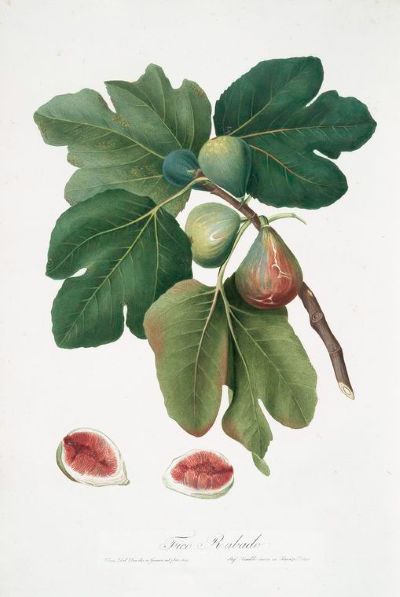Common Fig
Common Fig
Ficus carica L.
Mulberry Family — Moraceae
Description of Fig
Common fig is a deciduous tree or shrub, 3–10 m tall, with gray bark and spreading crown. Leaves alternate, lobed, 10–25 cm, dark green, rough, pubescent on the underside. Flowers small, hidden inside pear-shaped inflorescences (syconium). Fruits — juicy syconia, 3–8 cm, green, purple or black, sweet, with numerous small seeds. Varieties: ‘Kadota’, ‘Brown Turkey’, ‘Dalmatian’. Flowering April–May, fruiting July–October.
Distribution and Ecology of Fig
Native to the Mediterranean, Asia Minor, Caucasus. Grows in subtropical zones of Crimea, Central Asia, Transcaucasia, up to 1000 m above sea level. Cultivated in Turkey, Greece, Italy, USA, Georgia. Prefers light, well-drained soils (pH 6.0–7.5), sunny sites, watering 20–30 l/tree every 10–14 days. Propagated by cuttings, layers, seeds. Yield: 20–50 kg/tree. Care: pruning, potassium fertilization (15–20 g/m²), protection from scale insects, powdery mildew. Used in landscaping, as honey plant.
Raw Materials from Fig
Raw materials: fruits (fructus Fici), leaves (folia Fici). Fruits harvested July–October, dried at 40–50 °C (yield 20–25%). Leaves harvested June–July, dried at 40 °C (yield 15–20%). Quality: fruits — no mold, purple or green; leaves — green; moisture ≤12%. Store in airtight containers (fruits: 1 year; leaves: 1 year). Aroma sweet, taste sweet with slight sourness.
Chemical Composition of Fig
Fruits: water (80%), sugars (up to 20%), organic acids (malic, citric, up to 1%), pectins (up to 2%), vitamin C (up to 20 mg%), A, B1, B2, E, folic acid, flavonoids, minerals (K, Ca, Fe, Mg). Leaves: flavonoids, psoralens, coumarins, essential oil (up to 0.1%). Calorific value of fruits: 70–80 kcal/100 g (fresh), 250–300 kcal/100 g (dried).
Uses and Benefits of Fig
Fig has laxative, diuretic, anti-inflammatory, antioxidant, tonic effects. Used for constipation, bronchitis, anemia, hypertension, heart diseases, skin inflammations. Fruits improve digestion, strengthen bones, increase hemoglobin. Leaves help with psoriasis, eczema, dermatitis. Fruit juice reduces fever, improves blood circulation.
Precautions for Using Fig
Consumption >500 g/day fresh or >100 g/day dried fruits may cause diarrhea, flatulence. Store juice at 0–5 °C no longer than 24 hours. Give to children under 3 ≤30 g/day fruits. Leaves may cause photosensitization (avoid sun after application). Wash fruits thoroughly due to pesticides. Prolonged use of leaf infusions (>2 weeks) requires medical supervision.
Contraindications for Using Fig
Allergy to Moraceae, diabetes, gout, gastric ulcer in exacerbation, urolithiasis, pregnancy, lactation.
Medicinal Recipes with Fig
- Decoction of fruits for constipation. Boil 50 g dried fruits in 200 ml water for 15 min, drink 50 ml twice/day, 5 days.
- Infusion of leaves for dermatitis. Pour 10 g leaves with 200 ml boiling water, infuse 20 min, apply compresses 15 min, twice/day, 7 days.
- Juice for anemia. Drink 50 ml juice twice/day, 10 days.
- Decoction of fruits for bronchitis. Boil 30 g dried fruits in 200 ml milk for 10 min, drink 100 ml twice/day, 5 days.
- Fig syrup for cough. Blend 100 g fresh figs with 50 g honey, take 1 tbsp 3 times/day.
- Leaf tea for hypertension. Infuse 5 g dried leaves in 250 ml hot water for 10 min, drink 100 ml twice/day.
- Milk infusion for heart health. Boil 20 g dried figs in 300 ml milk, strain, drink warm 150 ml once/day.
- Fruit paste for digestion. Mash 50 g dried figs with 20 g prunes, consume 1 tsp daily.
Cosmetic Uses of Fig
Fig is used for skin care.
- Moisturizing mask. 20 g fruit pulp, 10 ml honey, apply for 15 min, rinse, twice/week.
- Lotion for oily skin. 20 ml juice, 10 ml water, wipe skin, once/day.
- Rejuvenating mask. 20 g pulp, 10 ml yogurt, apply for 20 min, rinse, twice/week.
- Leaf infusion for acne. Pour 10 g leaves with 100 ml boiling water, infuse 20 min, wipe skin, twice/day.
- Exfoliating scrub. Mix 15 g fig pulp with 10 g oatmeal, massage face gently, rinse after 5 min.
- Hair rinse for shine. Boil 20 g leaves in 500 ml water, cool, rinse hair after shampooing.
- Anti-aging serum. Blend 30 g fresh figs with 5 ml olive oil, apply to face for 10 min.
- Soothing compress for inflammation. Crush 2 fresh figs, apply pulp to affected area for 15 min.
Culinary Uses of Fig
Fruits used fresh, dried, in desserts, snacks.
- Compote. 200 g fresh fruits, 1 l water, 50 g sugar, boil 15 min.
- Jam. 1 kg fruits, 700 g sugar, 200 ml water, boil 40 min, store in jars.
- Fig salad. 100 g fresh fruits, 50 g cheese, 20 g nuts, dress with 10 ml olive oil.
- Smoothie. 200 g fruits, 100 ml yogurt, 10 g honey, blend.
- Baked figs. Halve 4 figs, top with honey and nuts, bake at 180 °C for 10 min.
- Fig chutney. Chop 300 g figs, cook with 100 g onion, 50 g sugar, vinegar for 20 min.
- Dried fig energy bars. Blend 200 g dried figs with 100 g dates and nuts, form bars, refrigerate.
- Fig pizza topping. Slice fresh figs, add to pizza with goat cheese and arugula before baking.
Tips: Store fresh fruits at 0–5 °C up to 2 weeks, dried — up to 1 year. Use ripe fruits for best taste.
Other Properties of Fig
Used in landscaping, as honey plant, for decorative purposes.




